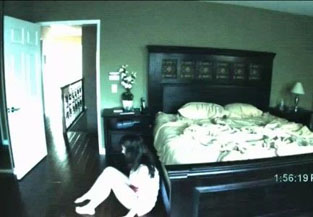Hollywood Psych: Paranormal Activity
By Sean Collier
October 19, 2009
BoxOfficeProphets.com

I have something of a busy schedule, though, so we had to set aside some dates. Our first shot was October 3rd, a couple Saturdays ago. I was leaning towards Strinestown, PA's fabulous Halloween Park – the world's only interactive haunted house – but Manni had different plans.
"Remember that movie Paranormal Activity I told you about?"
"Yeah." I had read some of the hype, but wasn't really sure what it was about. And I was sure it wasn't the world's only interactive haunted house. "Is it playing?"
"Well, yeah, but at Penn State." Three hours away. "We should go. They have this demand-it thing on the Web site, but Pittsburgh's like 17th on the list. I have to see this movie."
So, quite unexpectedly, I found myself packing up the car for a midnight screening of a horror movie, to be seen only through 150 miles of Pennsylvania highway.
This is what strong buzz looks like.
Paranormal Activity was originally seen as little more than a trial run for a big-budget remake. The $15,000 film impressed Steven Spielberg and DreamWorks Production Chief Adam Goodman, who pushed for novice director Oren Peli to remake the film with a bigger budget; when audiences started fleeing test screenings in terror, they realized they might have something special on their hands.
This is the point when Paranormal Activity became a gold mine. Buzz was building around the film – the initial screening at Slamdance was extraordinarily well received, and a apocryphal story about Steven Spielberg becoming so frightened that he believed his DVD to be haunted rattled around the web. The film's official Web site was posted, with the trailer focusing on terrified audience reactions.
People were talking about Paranormal Activity, and it still wasn't clear that the film would receive a release. Every showing, meanwhile, sold out. The Demand It! web service, usually used for concerts and other live performance, was employed; the appearance was that only the cities with the most demand would receive the film.
Two final trials were ahead. The first weekend in October, Paranormal Activity was released to a handful of theaters in large college towns – the screening I saw, in State College, PA, was one of these. Not only did nearly every showtime – and there were only a few per town – sell out, but it wasn't just me driving through the night to get to the movie. Word-of-mouth spread throughout the country (a nice side effect of releasing the film to colleges – college kids tell their friends back home, and you've got people in every neighboring city talking.)
With a small and very selective rollout – that followed the buzz for the film, instead of preceding it – DreamWorks had created a situation where supply (showtimes) didn't come close to meeting demand. When the final test run – one print and only one print showing in a few dozen mostly mid-sized markets – came along, nearly every show was filling up. Not just prime time, either – an employee I know said that last weekend, even afternoon showings on Friday were selling out. The Web site promised that if one million demands were filed on the Eventful site, a nationwide release would follow; the number was reached within a few days of the announcement.
Without this rollout, we probably wouldn't be talking about Paranormal Activity. Oddly enough, I'm reminded of the Cartmanland episode of South Park – Cartman opened a theme park, but no one was too impressed. Then he decided not to let anybody in. Suddenly, everyone wanted in. If you deny access to a product, people fight to get it. While Paranormal Activity is very good, even a very good horror movie released conventionally usually doesn't turn many heads – but DreamWorks built the interest long before they delivered the product and gave word of mouth time to work.
The lesson here is how much power word-of-mouth has. We usually regard it as a footnote – say, if a film does okay opening weekend, but is well received, it may not have a big second weekend drop due to positive word-of-mouth. But harnessed perfectly – which is tough – buzz can make millions. Keep in mind that word-of-mouth was basically the only thing Paranormal Activity had spurring it on – advertising was minimal, the actors and director were unknowns, and the plot is relatively simple – which makes it tough to sell. The film made money because people couldn't stop talking about it.
Tons of money, at that. While Paranormal Activity came in fifth in last weekend's box office race – about $8 Million from 160 theaters, good for a venue average near $50,000, and it climbed to third this weekend with a little over $20 million - stop for a moment and consider the film's budget. The highest reported figure was $15,000.
First off, that means that every screen that showed the film last weekend made the movie's money back three times over.
But more importantly, say that Paranormal Activity wraps up with a tally of $40 million (which will prove to be quite a conservative estimate.) For every dollar Oren Peli put into the film, then, he would've made $2,666.
That's a hell of an investment. It's not news that small films can be more profitable than big ones, assuming they hit – what's noteworthy about Paranormal Activity is that DreamWorks may have provided a blueprint for how a small film can get attention and make money.
A $15,000 horror film got me to drive across the state and back. (The big shocker – I didn't regret this decision, even after the movie showed up across the street six days later.) More importantly, though, it might complete change how Hollywood sells us movies.